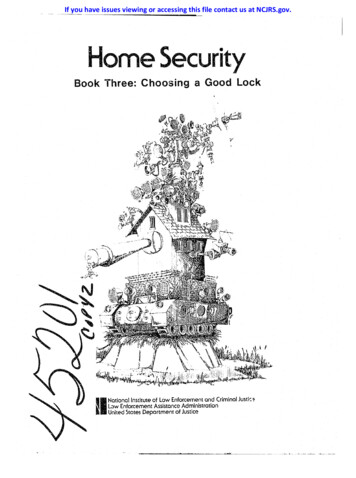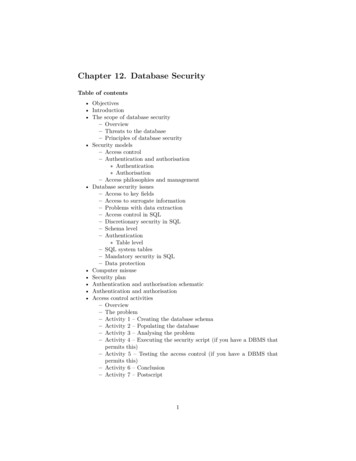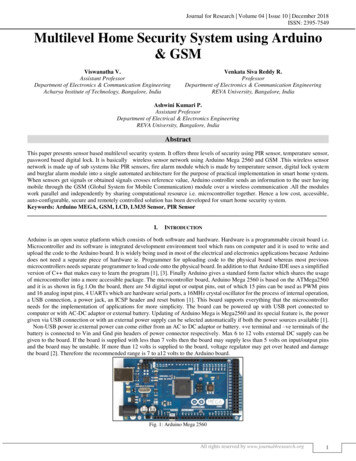
Transcription
If you have issues viewing or accessing this file contact us at NCJRS.gov.Home SecurityBook Three: Choosing a Good LockII INational Institute of Law Enforcement and Criminal Justit: L :lw Enfon:ement Assistance AdministrationUnited States Department of Justice
HOME SECURITYBOOK THREE: Choosing a Good LockJames Michael EdgarThis project was produced as a part of contract number J-LEAA-OlO-75awarded to the General Electric Company by the Law EnforcementAssistance Administration. Points of view and opinions contained in thismanual are those of the author and do not necessarily reflect the officialpositions of the Law Enforcement Assistance Administration or of theUnited States Department of Justice.------ ------- -----
- - - - - - - - - - - - - - - - - - - - - - - - - - - - - - - - - - - - - - - - .w A major part of your home securitydepends on your locks. Locks areprobably the only items in or onyour home that are there solely forthe purpose of providing a defenseagainst unwanted intrusion. Howwell they do their job depends on anumber of factors: their design,construction, installation, and proper application. The locks mostcommonly found in Americanhomes are door locks and padlocks.In this booklet we will concentrateon these two basic types of locks but the principles we will presentare also applicable to mostmechanical locking devices, re-·garc1less of their application.WHAT YOU DON'T NEEDIN A LOCKSome very good locks have featuresyou really don't need in your home.For example, you probably don'tneed a highly pick resistant lock.The ordinary residential burglarknows about as much about lockpicking as you do. An ordinaryfive-pin tumbler lock - which isthe type usually used for residential security - is usually adequate.Nor are you likely to need a lockthat contains hardened steel insertsto resist drilling. Few burglars willhave thought to bring a drill withthem, and it's even less likely thatthey're going to stick around forthe amount of time necessary todrill out your locks. Drilling locksis a professional burglar's technique, ann residential burglars arerarely professionals.Some very good locks contain deadbolts which are reinforced in various ways to resist sawing. Again,this is a feature that provides moresecurity than you are likely to need- ant;} at extra cost. The risk thata burglar will try to saw your lockbolt is negUgiblc. Extra featureslike these are fine on locks forcommercial buildings which aremore often the targets of skilledprofessional burglars. The 100 ormore price tag for these high security locks is reasonable in theseapplications. But for most residences these locks are more protection than you really need.What you really need is a gooddeadbolt lock that resists the common methods that a residentialburglar will likely employ to gainentry into your home. The case orbody of the locl( should be substantial enough to resist battering. Thecylinder should be installed in thecase or body with strong cylinderinterlock bolts. A good rule ofthumb is that interlock bolts lessthan 1/4" in diameter shouid besuspect. In most cases they are toosmall to adequately anchor thecylinder nnd can be broken orpulled out if enough force is applied. Either a long-throW horizontal deadbolt or a vertical-throwinterlocking deadbol t should beused. The lock bolt to be avoidedis the spring-loaded latch boltwhich is never adequate securityIf your locks areused alone.properly installed in a good door,and these simple rules are fallowed, your risk of being victimized by a burglar will be SUbstantially decreased. Most burglars getin by defeating inadequate locks.DOOR LOCKSDoor locks must withstand commonburglary attacks. Otherwise youmight as well not have them. Fortunately, the techniques used bythe residential burglar are not verysophisticated, and if your lo ks areimmune to them he will probablygive up and go away.- - - - ---------'- - - - ,- - - - - . "'L.--.oO. ' . . , .::.-
Avoid the Lock-In--KnobLocksetGetting the knob off is a verysimple matter. Even alleged llhighsecurity" lock-in-knob locksetswhich have been reinforced to resist attacks on the knob can usuallybe quickly defeated and are notworth the money (some are quiteexpensive). The best rule is toavoid them altogether. There aredeadbolt locks now on the marketwhich have been designed to replace the lock-in-knob lockset.One is illustrated in this booklet.They fit into the same hole in thedoor and are simple to install.They are relatively inexpensive andprovide good protection. They incorporate either a long-throw horizontal deadbolt or a vertical-throwinter.locking deadbolt, either ofWhich is usually adequate for residential protection.The most insecure door lock now incommon use is the lock-in-knoblockset. The basic rule of the useof locks for home security is neverrely on a lock-in-knob lockse"ffOrprotection against forced Emtry. Itis never adequate W1der any condition. ·On most deadbolt locks thelocking mechanism is buried in thedoor, or mounted on the inside ofthe door - out of reach of theburglar. Not so the lock-in-knoblockset. The lock mechanism isinside the doorknob and once theburglar has knocked, wrenched,twisted, or pried off the knob, themechanism is easily accessible.Types of Lock BoltsThere are two basic types of lockbol ts used in door locks, latch boltsand deadbolts. A latchbolt is short,spring-loaded, and has a beveledface (which makes it easy to identify). The horizontal deadbolt islong, not spring-loaded and has a.square face. Latchbolts are neveradequate protection. They are tooshort to securely fasten the door tothe door frame. They are alsospring-loaded which, from the pointof view of providing security, is avery dangerous feature.Latchbolts are designed to retract automatically when the door on whichthey are used is closing. Once thedoor is fully closed, the springpushes the bolt into the strike,latching the door closed. This isvery convenient, Which makesthese latches very popular. But itis not very secure. Older latchbolts can be shimmed by inserting apiece of thin, springy steel or stiffplastic between the door and· itsframe. This shim makes contactHORIZOtiTAL LQtlli-THROl DEADLOCK. A deadloc isany lock cont.:dning a deadbolt. Any horizontaldeadbolt must have a throw of at least one inchto be considered adequate security. Shorterthrow deadlocks are too vulnerable to framespreading, a common burglar attack,LOCK-IN-KNOB LOCKSETS al'e also known as cylindricallocksets or key-in-knob locksets. Used alonetheY are never sufficient protection. Alock-in-knob IOckset should be considered aprivacy latch (ather than a true lock. It mustalways pesupplemented with a good deadlockproperly mounted on the door.2:
least one-half inch, thereb T releasHe then simplying the door.pushes the door open and he's in.This type of attack (called I1framespreading" or fljamb spreading") isperhaps the burglar's most commonmethod of breaking in.with the beveled portion ot thelatchbolt, forcing it to retract.With a little practice a burglar canshim a latchbolt faster than youcan unlock it with a key. Newerlatchbolts contain anti-shim devices which make this attack impractical. But even with thesedevices to protect against shimming, locking latches are still ahazard. They must be made fairlyshorf: in order to retract properlywhen the door is closing. Seldomdo they have a throw of more than5/8 inch, which means that on properly mounted doors, they will extend into the strike no more thanone-half inch (There must be 1/8inch clearance between th6 doorand frame to enable the door tooperate without binding.) On poorlyhung doors, where the clearance ispermitted to be larger than 1/8inch, the latch may extend into thedoor as little as 1/4 inch. With asmall prybar or large screwdriver,a burglar' can easily apply enoughforce to the average door frame todeflect it away from the latch atLock-in-knob locksets are just oneof many kinds of locks that containlocking latches rather than deadbolts. Any lock which relies solelyon a latchbolt should be replaced,or a good dead ock added. There isno condition· 'in which a lockinglatchbolt by itself is adequate protection against the burglar.Some deadbolts) however are alsoinadequate, and you should also becareful to avoid these. The mostcommon fault, again, is that somedeadbolts are simply too short also about 5/8 inch. Obviously ashort deadbolt provides no moreprotection against frame spreadingthan a latchbolt of the samelength. fiorizontal-throw deadboltsshould be at least one full inch longVERTlCAL-THRmr OEADBOLT PRIMARY DOOR LOCK.Escutcheon P\ ateCyl inder Guard Device(Real' View)Mostvertical-throw deadlocks are designed to supplement the primary door lQck \ hich is usually avariety of the lock-in-knob locKset, The lockillustrated. however, is designed as a primarydoor lock featuring the security of a verticalthrow deadbolt. It is intended to replaceexisting lc k-in-knob locksets as the prii1larydoor lock and requires no auxiliary deadlock.; ' ,High Security StrikeInterior Operating Hand1e(Also available withinterior cylinder)Spring-lo&aedNon-Lock1 rig La tch 3. ,
when measured as shown in theaccompanying illustration.Anything less is not adequate protection.Most security experts agree thateven better protection can beachieved by using an interlockingdeadbolt. The most common ofTYPES OF lOCK BOLTSHORIZONTAl-THROVI DEAOBOlTS. If horizontalthrow dead bolts are used, the bolt shouldextend at least one inch from the leadingend of the door. r ost common (short-throw)deadbolts extend only one-half to fivp.-eighthsinches which does not provide the securityneeded.latchbolt Ilith Anti-Shim Device and Strike:This type of bolt is' -adequate - protection and should not be used exceptwith an auxiliary deadlock. ntj-ShimDevicelong-Throw Deadbolto!iori zontillong-Throw Deadbo 1t and Stri ke:Throw is measured from the face pl ate tothe end of the bol t with the bolt in thefully extended position.Short-Throw DeadboltVERTICAl-THROW INTERLOCKING DEADLOCK is thetype of interlocking deadlock most commonlyused on residential do·)rs. It interlocksthe door frame to the door providing goodprotection against frame-spreading. If notproperly mounted with through-the-door cylinderinterlock bolts, however, it is subject tobeing defeated by other types of attacks,especially punching. If properly mounted, itis excellent protection.4----------------- . . . . .
these for residential applications isthe vertical-throw deadbolt shownin the accompanying illustration.Properly mounted, it interlocks thedoor and frame in a manner thatmakes frame spreading nee.i'ly impossible. For this reason they areoften preferred even to long-throwdeadbolts.It is usually held in place by smallbol ts in the leading edge of thedoor.Today these are usuallyfound only on hollow steel doors.Ordinarily it would take a burglar aconsiderable amount of time tohammer or chop one of these out ofthe door - so in that regard theyare pretty safe. The weakness ofmortise locks is that their cylindersare usually fairly easy to pull orwrench from the body of the lock,and they should be protected bycylinder guards.Installing Locks SecurelyMost of today's in-the-door deadloc\ :s (A deadlock is any lock containing a deadbol t.) are designedto be installed with steel interlockscrews.These machine screws(more commonly called "boltsll byeveryone but engineers) join a metalportion of the lock on the inside ofthe door to another metal part onthe outside. Metal-to-metal is thekey concept. This type of mounting in effect creates a sandwich ofmetal with the wood (or steel) doorin the middle making it extremelydifficult to punch, pull or hammerthe lock out of the door.LOCKS SHOULD BE 'OUtlTED InTH INTERLOCK t ACHINESCREWS (BOLTS). NOT WITH WQOD OR SHEET METALSCREWSWood and sheet metal screws should not be usedto mount locks to doors. They do not haveadequate holding power to resist forcefulattacks. Mac'line screws (r.ol11l1only called"bolts") which fasten one half of thelock on the interior to the other half onthe exterior of the door are much moresecure. Sheet Metal ScrewIn contrast to in-the-door locks,Wood Screwmost inexpensive rim-mounteddeadlocks are attached to the surface of the door with wood or sheetmetal screws. They are nearlyworthless. They can be quickly andeasily knocked off the door with apunch and hammer. Your best buyis a rim mounted lock which installs with bolts extending throughthe door. Again the key concept ismetal-to-metal.Locks mountedwith through-the-door bolts cannotbe knocked off by punching withinthe amount of time the averageburglar wants to spend exposed onyour doorstep.Proper tlounting (Simpl ifiec! Illustration)InteriorExteriorOne exception to this metal-tometal rule is the mortise deadlock.A mortise lock fits inside the doorin a cavity cut out for this purpose.Door (end view)5
CYLINDER GUARDSSo, to be on the safe side, use acylinder guard. Many good lockscontain e built-in steel cylinderguard which completely enclosesthe eXL'osed part of the cylinder.The guard prevents the burglarfrom wrenching or pulling the cylinder. If you have an otherwisegood lock which does not have acylinder guard, you can add one.There are a variety of add-ong11ards which fit over most cylinders. These are well worth the fewdollars investment.A common method used by residential burglars to ol?en your locks iscylinder pulling or wrenching. Allhe needs is a pipe wrench. If thecynnder is exposed enough so theburglar can get a wrench on it, hecan twist it until the mountingbol ts break or are pulled out of thecylinder. There are also ways ofyanking the cylinder even if it isnotexposed enoughto bewrenched.DEFEATlNG EXPDsm DEADLOCKS BY WRENCHING THECYlltJ!:!r;R lUT OF THE LOCK BODY. This commollburglar athck can be prevented by installinga cylinder guard which encloses the cylinder.ADD-ON CYLINDER GUARD. Many good locks aredesigned with built-in cylinder guards toprevent attacks on the cylinder itself.If your lock does not contain a built-inguard. an add-on guard 1i ke the one shownprovides excel1ent security. This commerciallyavailable guard is of heavy aluminum and ismounted from the i ns1 de of the clOor withhardened steel bolts that enter threadedholes in the guard. It combines goodprotection with good appearance.6
STRIKESStrikes are the major weakness ofmany otherwise fine locks. Thereis one simple rule to follow whendeciding on an appropriate strike the common strike mounted withtwo short screws is goodenough. As a minimum, you mustremount the strike with long (2 3/4inch) screws after you've filled thegap between the doorframe andstuds (see Book One). Many goodlocks come with security strikeswhich are much larger than com-mon strikes and are mounted withat least four long screws. Manywrap around the door frame andare mounted with several screws at90 degree angles to each other.These wraps.rounds are usuallysuperior. They have more holdingpower, ailil serve to reinforce theframe itself so it doesn't breakwhen force is applied to the lock.Your locksmith usually has a number of security strikes on hand andwill be glad to help you select theone most appropriate for yourneeds.HIGH SECURITY STRIKE BOX. This stri ke isdesigned for use with horizontal-throwdeadlocks. It;s intended to overcome thesecurity limitations of wood door jambS.The strike is mounted with four long screws,two of \ hich are offset to increase theirholding po\ er against forceful attacks.jamb (door frame)TOP VIEWStud- .f--- l-H--Hfti-- I 1 -- stud7
Don't you do it.Follow thesesimple rules and be safe.SUMMARYThe basic rules for choosingsecure door locks aretTHE PADLOCK MUST HAVEA TUMBLER MECHANISM1. Avoid the lock-in-knob lockset it's useless. Replace it or supplement it with a good deadbolt lock.A padlock should contain a tumblermechanism just like your doorlocks. Some inexpensive padlocksdo not have tumbler mechanisms.They are similar to locks you usedto see on old houses that anyonecould open with a skeleton key.These are called warded locks.While the keys on warded padlocksdon't look like old sl eleton keys,they work on the same principleand they are not secure.Anamateur burglar could open one2. The only two acceptable boltsto use on swinging doors are thelong-throw (at least one inch) deadbolt or interlocking deadbolt. Formost applications the interlockingdeadbol t is preferred.3. All locks (except mortise locks)must be mounted with through-thedoor cylinder interlock bolts,(machine screws) or other, nonremovable bolts. The bolts must besteel, not nylon or soft metal.Don't use wood or sheet metalscrews to mount a lock.COflNON METHODS OF S CURING A SHACKLE INSIDE THE PADLOCK BODY4. Security strikes should be used preferably the wraparound type. Ifyou retain your common strike,remount it with long screws afterfilling the gap between the doorframe and studs.Toe of Shackle5. Cylinder guards should be usedwith all locks. These may be eitherthe built-in or add-on type. Theyare an absolut must 0.11 most mortise and many rim-mounted locks.Padlock BodyPADLOCKSPad lock 1·lith Spring-LoadedLocking Dog (Toe Locking).Toe ofShackleHeel of ShacklePadlocks are used in many placeswhere built-in locks can't be usedor were not provided. Your garage,storage shed, and bicycle are probably secured with padlocks (if theyaren't they sure should be). f"adlocks can be very effective inresisting common residential bUrglar attacks. Where a burglar getspast a padlock, it's usually becausesomebody used an inexpensive padlock to protect valuable items.Padlock BodyPositive-Locking Padlock in Locked PositionNee 1 and Toe Locklrig";The a6sence of springs eliminated the riskof shimmi n9 the I o k open.8
with a bent hairpin. When you buya padlock, make sure it contains atumbler mechanism. Its key shouldlook something like your front doorkey - and it will usually be described as a tumbler mechanism onthe box it comes in. If you're notsure, ask the salesman. If he's notsure, don't buy it.POSITIVE LOCKINGSeveral methods are used to securethe shackle to the case. The leastsecure of all involve springloadedlocking. A void these. They canoften be shimmed by inserting athin strip of metal alongside theshackle down into the case.Always look for positive locking.No springs are involved in positivelocking, and the padlock cannot beshimmed. It's usually easy to tellspring-loaded locking from positiveWhen springlocking padlocks.l.oFlded padlocks are unlocked, the&1' . .:kle will ·"·ting open. When apG.:' .:iveIe . :ngpadlockisunlocked? ttL. ::- !kle has to bepulled open. Ab/.L:, read the boxes.It should tell you whether thepadlock is positive locking.Not so the padlock. The casecontaining the mecharism is dangling at the end of its shackle fUllyexposed to whatever force a bUrglar might care to apply. Goodpadlocks are made with hardenedsteel cases - look for them. Somelaminated cases are also fairly secure - but it would take an expertto tell the good ones from theflimsy ones. Ask the salesman, orcheck with a locksmith or a policecrime prevention officer beforebuying one.THE SHACKLE MUST BECASEHARDENED AND SHIELDEDOne of the burglar's favorite waysof getting past a padlock is to cutor saw the shackle. With someinexpensive padlocks, this approachis quick and easy. But the better ":::V -Hardened Steel ShackleSteel Shackle Guard---f.-Heavy Steel CaseHIGH SECURITY PADLOCKHEEL AND TOE LOCKINGhow little of theisNoteexposedto potentia I attackshac leThe shackle must lock on bothends: tlle IIhee111 (the end permanently fixed to the case) and the"toe" (the end which disengages).Otherwise a burglar can pry out theunlocked end with little effort.Heel-and-toe locking padlocl{s havelocking notches on both ends ofthe shackle. Check for therl1 ShackleToe (Removable endshackle)of11111lLaminated Lock BodylTHE CASE MUST BE 'H)UtHiThe body of your doorlocks areeither buried in' (hi,?, door, orimmedimounted to the back ."ately accessible to the bW'i,, ar (except for the locl -in-knob 10cl 8et).tedLAtHNATED PADLOCK:Rivetposition.This is a typicallamfn padlock in an unlockedThe body consists of plates riveted, bril2.ed.or soldered together. It provides o lyI imitcd protection lind is subject to a widevariety of attacks. Note the exposedshackle.9
padlocks are protected against cutting and sawing by casehardeningthe shackle and by extending thecase so that it shields most of theshackle making it inaccessible tothe burglar. On one model, theshackle is entirely covered by thecase when the padlock is locked.have in mind will do the job.DON'T RELY SOLELY ON LOCKSGood locks are an essential part ofyour home security, but only whenthey are part of a total securitysystem. A burglar will pick theweakest point to make his entry. Ifyour lock is good, but your door isweak, he'll ignore your lock andbreak down your door. It's thatsimple. A lock is only as good asits strike, the door it's mounted on,and the door frame. Each of theseshould provide an equal level ofprotection.THE HASPNo padlock is any better than thehasp it engages. Hasps must themselves be casehardened because theburglar is as likely to attack thehasp as he is to attack the J; adlockitself. It should be designed so thatno mounting bolts are exposedwhen it is closed and locked. Otherwise the burglar will just unboltit. It must be securely mountedwith bolts not wood or sheet metalscrew8.Don't mount it on thin orrotting wood, or thin metal withoutreinforcing the back of the mounting surface with a steel plate.And, of course, now that you've gotgood locks, don't forget to usethem. If you want to keep it,you've got to lock it. It couldn't besimpler.If you use a chain with a padlock,make sure the chain is casehardOtherwise, even if theened.burglar can't cut your shackle, hecan cut the chain, and you've justwasted your money on that newpadlock.OTHER LOCKSThere are so many specialty locksthat we cannot begin to cover themall here. But many of the samegeneral rules apply. Always lookfor sturdiness, good steel and avoidsprings. Any lock used for securitymust contain a tumbler mechanism- otherwise it's too easy to open.Seek advice on any lock before youbuy. Your local locksmith can helpyou, so can your police or sheriff'scrime prevention unit. Usually thepolice cannot recommend a specific make of lock - but they usuallywill tell you whether a lock you10 u. .GOVERNMENT PRIN11NG OFFICEt '978-2GO-997/IG,.
U,S, DEPARTMENT OF JUSTICELAW ENFORCEMENT ASSISTANCE ADMINISTRATIONWASHINGTON, D.C. 20531OFFICIAL BUSINESSPOSTAGE AND FEES PAIDU.S. DEPARTMENT OF JUSTICEJUS·436PENALTY FOR PRIVATE USE, 300THIRD CLASS
------ ------------------------------------------------. . . . . .L c .
knows about as much about lock picking as you do. An ordinary five-pin tumbler lock - which is the type usually used for residen tial security - is usually adequate. . practical.










